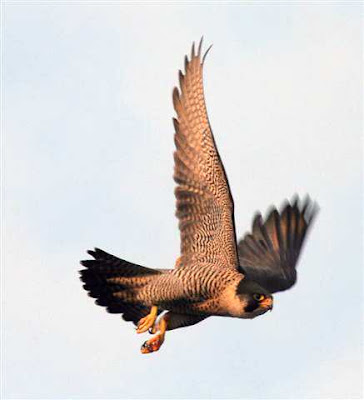
Stories seem to be emerging from the US of high levels of fire retardant chemicals being found in the eggs of peregrine falcons, after samples were analysed from birds in San Jose, California. One can't help wondering how widespread this could turn out to be, or even if there could be a repeat of damage to top predators from the chemicals we casually put into the environment, just as there was through the use of DDT in the 1950s and 1960s. You can read more by following these links:
2008 article
2003 article
 Either way, because of its position at the top of the food chain, the peregrine falcon could once again prove to be a valuable indicator of the state of our environment. The work of individual enthusiasts and ornithologists can be most useful in this task. Shown below is a "hatchtable" compiled by one peregrine enthusiast, Froona, in Holland which shows the nesting performance of peregrines in various parts of the Europe and North America. The four chicks that recently hatched in Columbus, Ohio are the only additions to add to these nest results for 2008. Interestingly, no eggs hatched there last year, so it's important never to rush to draw conclusions about breeding success without firm evidence, carefully collected and studied.
Either way, because of its position at the top of the food chain, the peregrine falcon could once again prove to be a valuable indicator of the state of our environment. The work of individual enthusiasts and ornithologists can be most useful in this task. Shown below is a "hatchtable" compiled by one peregrine enthusiast, Froona, in Holland which shows the nesting performance of peregrines in various parts of the Europe and North America. The four chicks that recently hatched in Columbus, Ohio are the only additions to add to these nest results for 2008. Interestingly, no eggs hatched there last year, so it's important never to rush to draw conclusions about breeding success without firm evidence, carefully collected and studied.History of a different sort should be made tomorrow morning when we can announce the next development in the Derby Cathedral Peregrine Project. It's something we've been working on for some months now, and we hope it will bring more enjoyment and an even closer insight into the lives of our fantastic birds, here in Deby's city centre.
Meanwhile follow these links to:
- find out about buying the brand new DVD: "The Peregrines of Derby Cathedral")
- read an overview of the peregrine project,
- add your name to our mailing list
- see many more pictures on Froona's very detailed blog over in Holland (both from our webcams and from many others around the world)


3 comments:
Excellent info Nick about the eggs -Rochester 5 hatched, thats going to be a handful. Hope the scrapes big enough.
Not so good about the fire retardant chemicals. Lets hope it limited cases.
Well I can't imagine what your 'next development' could be. How can you beat streaming video! I got my wish, the chicks are currently being fed and 'tiddler' is right up there in front, getting most of the prey. The others are only mildy interested so it's wonderful to see they are so well fed. I've been kicked off a couple times now but just want to wait until I hear the bells before logging off. Thanks again. Veronica in Cornwall.
I appreciate the still photography that appears from time to time and would love to know the technical details,cameras/settings,etc.this also takes very special skills,so thanks to all concerned.
Every passing day increases the eyasses chance of survival,despite the drastic weather changes were having.Good luck to everybody involved.
Dennis,local lad.
Post a Comment